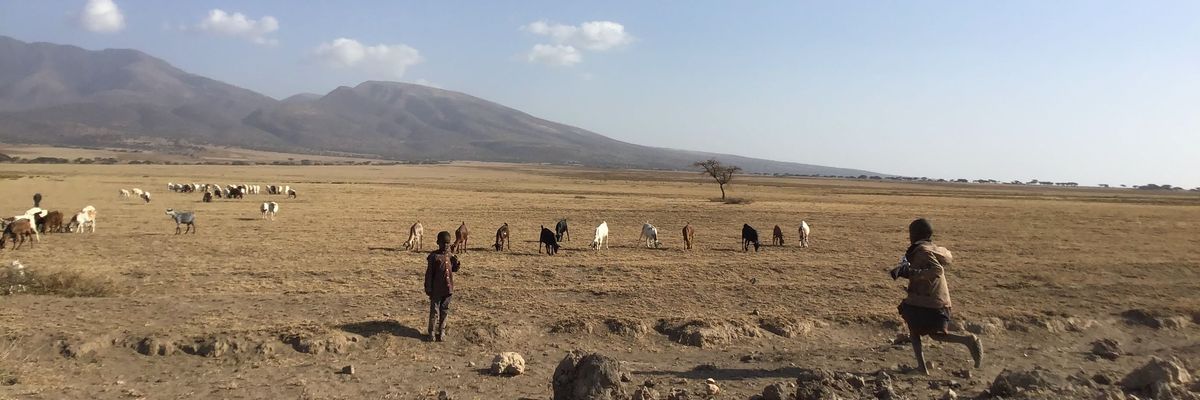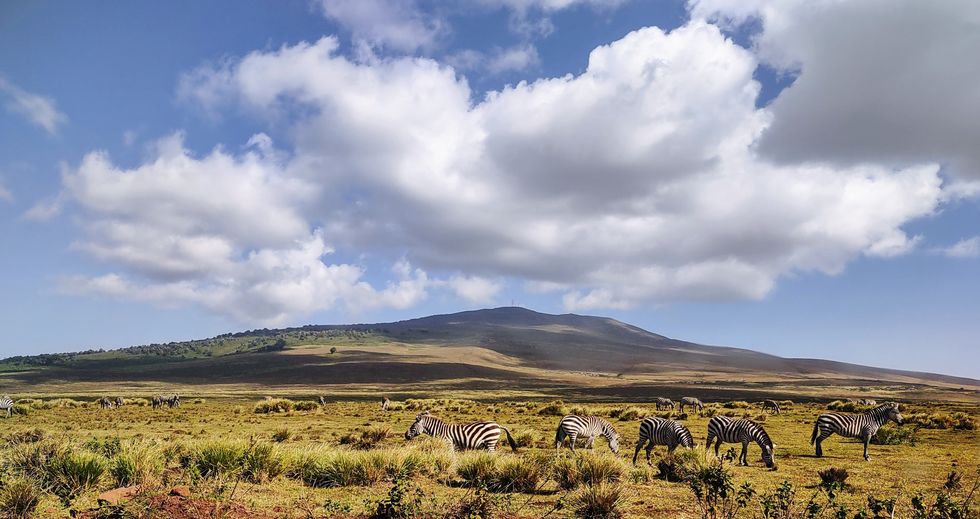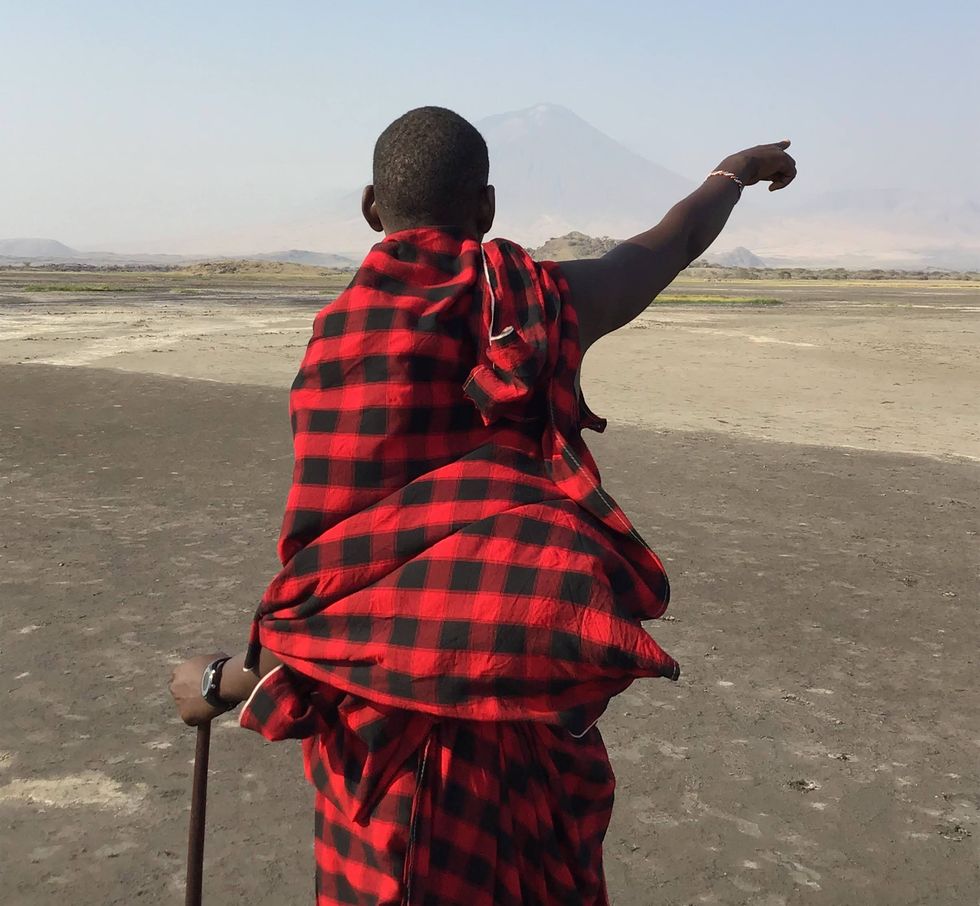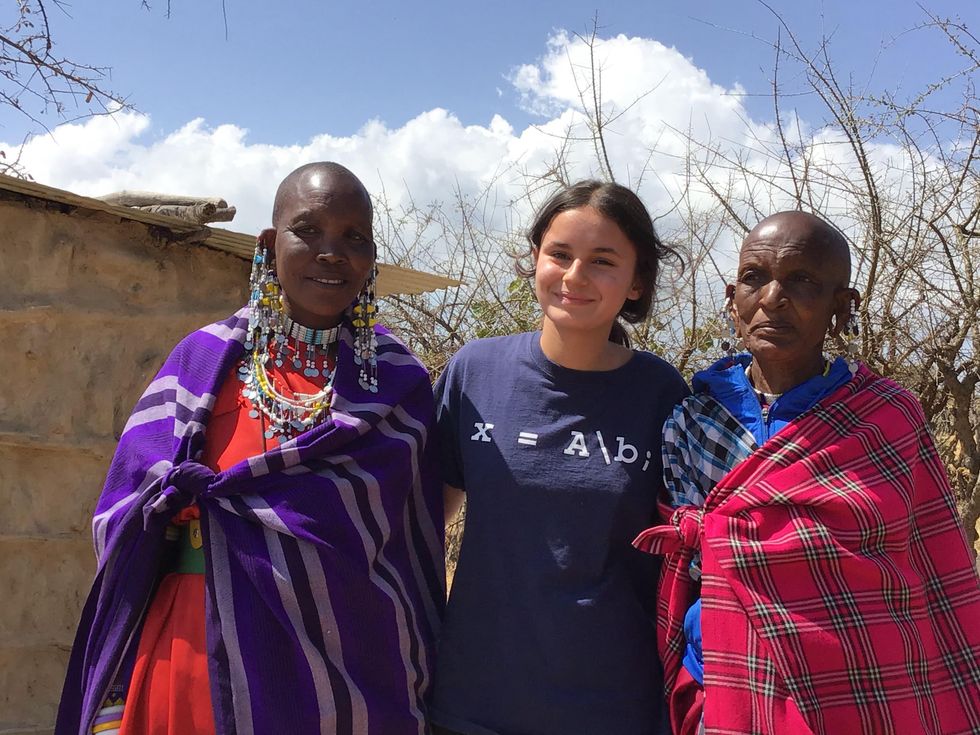

SUBSCRIBE TO OUR FREE NEWSLETTER
Daily news & progressive opinion—funded by the people, not the corporations—delivered straight to your inbox.
5
#000000
#FFFFFF
To donate by check, phone, or other method, see our More Ways to Give page.


Daily news & progressive opinion—funded by the people, not the corporations—delivered straight to your inbox.

Maasai herders watch their cattle in Tanzania.
In recent years, the resilient and courageous Maasai communities of Tanzania have been faced with a challenge previously unmatched—“fortress” conservation.
We journeyed through the dirt tracks in the middle of the savanna—the vibrant crimson of the Maasai shukas making cardinal dots in the arid landscape. Zebras grazed in polyphony with cows, and the occasional giraffe paced gracefully, stretching its freckled neck towards the sky. Wildebeest and gazelles stampeded through the lands, a cloud of dust trailing behind them.
From the Serengeti to the Ngorongoro Conservation Area, the landscapes of northern Tanzania are mesmerizing. The Ngorongoro Crater, often referred to as the “eighth wonder of the world,” is a natural marvel—a massive volcanic caldera teeming with wildlife amidst many shades of lush golden hues. But what made this journey both heartfelt and heartbreaking was my time with the Indigenous Maasai who have traditionally inhabited the area, which in their mother tongue Maa is described as “the lands that run forever.” The complex but harmonious relationship between living creatures here is striking; the Maasai do not hunt the wild animals residing in the bush—they share the land with them.
For centuries, the Maasai have resided in the African Rift Valley, roaming the land with their cattle who graze on the available shrubbery and grass. Their deep connection to the land is woven into their identity, culture, and spirituality. This life has its challenges—the dry season being a perfect example of the elements they endure—harsh, scorching, dusty wind, with scarcity of water and grass for their cattle. But, in recent years, the resilient and courageous communities have been faced with a challenge previously unmatched—“fortress” conservation.
The Maasai face forced evictions from their homelands, where their traditional way of life is under attack. Their lives and livelihoods are getting buried under government plans for tourism and hunting desired by the foreign elites with “greed like hyenas,” as described by a Maasai village leader. This situation has sparked a fiery international debate on supposed conservationist goals, the rights of Indigenous communities, cultural preservation, and sustainable development.

Zebra graze in the savanna in Tanzania.
(Photo: Soleil-Chandni Mousseau)
The rationale behind the evictions that the Maasai face uses euphemisms of environmental, wildlife, and biodiversity protection. International conservation groups and the Tanzanian government justify “fortress” conservation by asserting that these measures are necessary to combat habitat destruction, poaching, and other environmental challenges.
Contrarily, villagers and community officials blame safari tourism as the cause of their plight. The tourism sector in Tanzania has ballooned rapidly—rising from $1.74 billion in 2004 to $4.48 billion in 2013. Today, it is second only to manufacturing in contributing to the country’s national income. This boom doesn’t seem to be stopping anytime soon; the Tanzanian government’s goal is to attract five million visitors annually to generate US$6 billion from tourism revenue.
A member of the Maasai community, whom I met in the Ololosokwan village, shared, “Tourists enjoy this beautiful landscape and wildlife that has been conserved by the Maasai pastoralists. And we face displacement.” Not honoring the true conservators—the Maasai—demonstrates the twisted logic of the Tanzanian government and the promoters of top-down neocolonial conservation models—tourists trump the livelihoods of the Maasai people.
Displacement from their ancestral lands has profound consequences for the Maasai. They are losing their livelihoods, social structures, and access to essential services like hospitals, water, and grazing lands for their cattle, and more. Disruption of their way of life is leading to increased poverty, loss of cultural identity, and disintegration of the communities’ social fabric.
An end to organized attacks on the Maasai’s traditional way of life is nowhere in sight. The government has not hesitated to use military force in villages, inflicting fear and chaos among the communities. On June 8, 2022, during the demarcation of 1,500 square kilometers (approximately 579 square miles) for a game reserve in Loliondo, community members who were protesting were shot at. Dozens were severely injured, including an 81-year-old who remains missing. Thousands, especially women and children, were forced to flee to the border with Kenya, facing the challenges of homelessness and displacement. Twenty-five Maasai villagers, including 10 local district councilors, were arrested and kept in jail for months on false charges. One of the arrested leaders spent six months in prison—away from his then-pregnant wife and his sons. He shared, “I had two prisons. One that I lived in and one of my thoughts, as I think of her [my wife]. The baby was born when I was in jail.”
Though they face severe hardships, the resilience and bravery of the Maasai shines through. In May 2022, a group of villagers went to Germany, one of Tanzania’s colonizers, to advocate for their human and land rights. They met with the Frankfurt Zoological Society, which continues to play a key role in promoting the neocolonial conservancy agenda that devastates countless lives. They would have five to six meetings each day, informing people on what the Maasai face as they struggle for their future. “I spoke for the Maasai community who undergo these sufferings,” said one of the participants of this trip.
Another village representative powerfully stated, “They take my land. They take my life. If land is taken—it is the end of life.”

A member of the Maasai community in Tanzania points into the distance.
(Photo: Soleil-Chandni Mousseau)
The forced evictions of Indigenous communities contradict the principles of the United Nations Declaration on the Rights of Indigenous Peoples, which recognizes their rights to self-determination, to land, and other vital resources. It also undermines the goal of achieving sustainable development, as the well-being of both the environment and the people living within it are connected. Critics of the “fortress” conservation model argue that these evictions are not only an infringement on the Maasai’s human rights, but that they are also counterproductive to conservation efforts. The Maasai people’s traditional knowledge, built over centuries, contributes to sustainable land management practices that help preserve biodiversity and prevent environmental degradation.
As the summer comes to an end, and the reality of junior year looms over me, I think less about my college admissions and exams. My experience in Tanzania not only gave me photographs and souvenirs, but a profound appreciation for the true stewards of the land, the Indigenous Maasai—for whom land is life. Their sacred connection to the land and their commitment to preserving it is a powerful reminder of what true conservation is.
As I return to the Bay Area—in my privileged bubble of air conditioning and concrete roads, dogs in strollers, and six-lane highways—I hold on to the Maasai’s powerful words. Their resilience fuels my determination toward continuing to learn about their struggle to protect the delicate balance between humanity and nature, while challenging this form of neocolonialism—another chapter of the West scrambling to get a fraction of Africa’s eternal wealth and beauty.

The author stands with two members of the Maasai community.
(Photo: Soleil-Chandni Mousseau)
Dear Common Dreams reader, The U.S. is on a fast track to authoritarianism like nothing I've ever seen. Meanwhile, corporate news outlets are utterly capitulating to Trump, twisting their coverage to avoid drawing his ire while lining up to stuff cash in his pockets. That's why I believe that Common Dreams is doing the best and most consequential reporting that we've ever done. Our small but mighty team is a progressive reporting powerhouse, covering the news every day that the corporate media never will. Our mission has always been simple: To inform. To inspire. And to ignite change for the common good. Now here's the key piece that I want all our readers to understand: None of this would be possible without your financial support. That's not just some fundraising cliche. It's the absolute and literal truth. We don't accept corporate advertising and never will. We don't have a paywall because we don't think people should be blocked from critical news based on their ability to pay. Everything we do is funded by the donations of readers like you. Will you donate now to help power the nonprofit, independent reporting of Common Dreams? Thank you for being a vital member of our community. Together, we can keep independent journalism alive when it’s needed most. - Craig Brown, Co-founder |
We journeyed through the dirt tracks in the middle of the savanna—the vibrant crimson of the Maasai shukas making cardinal dots in the arid landscape. Zebras grazed in polyphony with cows, and the occasional giraffe paced gracefully, stretching its freckled neck towards the sky. Wildebeest and gazelles stampeded through the lands, a cloud of dust trailing behind them.
From the Serengeti to the Ngorongoro Conservation Area, the landscapes of northern Tanzania are mesmerizing. The Ngorongoro Crater, often referred to as the “eighth wonder of the world,” is a natural marvel—a massive volcanic caldera teeming with wildlife amidst many shades of lush golden hues. But what made this journey both heartfelt and heartbreaking was my time with the Indigenous Maasai who have traditionally inhabited the area, which in their mother tongue Maa is described as “the lands that run forever.” The complex but harmonious relationship between living creatures here is striking; the Maasai do not hunt the wild animals residing in the bush—they share the land with them.
For centuries, the Maasai have resided in the African Rift Valley, roaming the land with their cattle who graze on the available shrubbery and grass. Their deep connection to the land is woven into their identity, culture, and spirituality. This life has its challenges—the dry season being a perfect example of the elements they endure—harsh, scorching, dusty wind, with scarcity of water and grass for their cattle. But, in recent years, the resilient and courageous communities have been faced with a challenge previously unmatched—“fortress” conservation.
The Maasai face forced evictions from their homelands, where their traditional way of life is under attack. Their lives and livelihoods are getting buried under government plans for tourism and hunting desired by the foreign elites with “greed like hyenas,” as described by a Maasai village leader. This situation has sparked a fiery international debate on supposed conservationist goals, the rights of Indigenous communities, cultural preservation, and sustainable development.

Zebra graze in the savanna in Tanzania.
(Photo: Soleil-Chandni Mousseau)
The rationale behind the evictions that the Maasai face uses euphemisms of environmental, wildlife, and biodiversity protection. International conservation groups and the Tanzanian government justify “fortress” conservation by asserting that these measures are necessary to combat habitat destruction, poaching, and other environmental challenges.
Contrarily, villagers and community officials blame safari tourism as the cause of their plight. The tourism sector in Tanzania has ballooned rapidly—rising from $1.74 billion in 2004 to $4.48 billion in 2013. Today, it is second only to manufacturing in contributing to the country’s national income. This boom doesn’t seem to be stopping anytime soon; the Tanzanian government’s goal is to attract five million visitors annually to generate US$6 billion from tourism revenue.
A member of the Maasai community, whom I met in the Ololosokwan village, shared, “Tourists enjoy this beautiful landscape and wildlife that has been conserved by the Maasai pastoralists. And we face displacement.” Not honoring the true conservators—the Maasai—demonstrates the twisted logic of the Tanzanian government and the promoters of top-down neocolonial conservation models—tourists trump the livelihoods of the Maasai people.
Displacement from their ancestral lands has profound consequences for the Maasai. They are losing their livelihoods, social structures, and access to essential services like hospitals, water, and grazing lands for their cattle, and more. Disruption of their way of life is leading to increased poverty, loss of cultural identity, and disintegration of the communities’ social fabric.
An end to organized attacks on the Maasai’s traditional way of life is nowhere in sight. The government has not hesitated to use military force in villages, inflicting fear and chaos among the communities. On June 8, 2022, during the demarcation of 1,500 square kilometers (approximately 579 square miles) for a game reserve in Loliondo, community members who were protesting were shot at. Dozens were severely injured, including an 81-year-old who remains missing. Thousands, especially women and children, were forced to flee to the border with Kenya, facing the challenges of homelessness and displacement. Twenty-five Maasai villagers, including 10 local district councilors, were arrested and kept in jail for months on false charges. One of the arrested leaders spent six months in prison—away from his then-pregnant wife and his sons. He shared, “I had two prisons. One that I lived in and one of my thoughts, as I think of her [my wife]. The baby was born when I was in jail.”
Though they face severe hardships, the resilience and bravery of the Maasai shines through. In May 2022, a group of villagers went to Germany, one of Tanzania’s colonizers, to advocate for their human and land rights. They met with the Frankfurt Zoological Society, which continues to play a key role in promoting the neocolonial conservancy agenda that devastates countless lives. They would have five to six meetings each day, informing people on what the Maasai face as they struggle for their future. “I spoke for the Maasai community who undergo these sufferings,” said one of the participants of this trip.
Another village representative powerfully stated, “They take my land. They take my life. If land is taken—it is the end of life.”

A member of the Maasai community in Tanzania points into the distance.
(Photo: Soleil-Chandni Mousseau)
The forced evictions of Indigenous communities contradict the principles of the United Nations Declaration on the Rights of Indigenous Peoples, which recognizes their rights to self-determination, to land, and other vital resources. It also undermines the goal of achieving sustainable development, as the well-being of both the environment and the people living within it are connected. Critics of the “fortress” conservation model argue that these evictions are not only an infringement on the Maasai’s human rights, but that they are also counterproductive to conservation efforts. The Maasai people’s traditional knowledge, built over centuries, contributes to sustainable land management practices that help preserve biodiversity and prevent environmental degradation.
As the summer comes to an end, and the reality of junior year looms over me, I think less about my college admissions and exams. My experience in Tanzania not only gave me photographs and souvenirs, but a profound appreciation for the true stewards of the land, the Indigenous Maasai—for whom land is life. Their sacred connection to the land and their commitment to preserving it is a powerful reminder of what true conservation is.
As I return to the Bay Area—in my privileged bubble of air conditioning and concrete roads, dogs in strollers, and six-lane highways—I hold on to the Maasai’s powerful words. Their resilience fuels my determination toward continuing to learn about their struggle to protect the delicate balance between humanity and nature, while challenging this form of neocolonialism—another chapter of the West scrambling to get a fraction of Africa’s eternal wealth and beauty.

The author stands with two members of the Maasai community.
(Photo: Soleil-Chandni Mousseau)
We journeyed through the dirt tracks in the middle of the savanna—the vibrant crimson of the Maasai shukas making cardinal dots in the arid landscape. Zebras grazed in polyphony with cows, and the occasional giraffe paced gracefully, stretching its freckled neck towards the sky. Wildebeest and gazelles stampeded through the lands, a cloud of dust trailing behind them.
From the Serengeti to the Ngorongoro Conservation Area, the landscapes of northern Tanzania are mesmerizing. The Ngorongoro Crater, often referred to as the “eighth wonder of the world,” is a natural marvel—a massive volcanic caldera teeming with wildlife amidst many shades of lush golden hues. But what made this journey both heartfelt and heartbreaking was my time with the Indigenous Maasai who have traditionally inhabited the area, which in their mother tongue Maa is described as “the lands that run forever.” The complex but harmonious relationship between living creatures here is striking; the Maasai do not hunt the wild animals residing in the bush—they share the land with them.
For centuries, the Maasai have resided in the African Rift Valley, roaming the land with their cattle who graze on the available shrubbery and grass. Their deep connection to the land is woven into their identity, culture, and spirituality. This life has its challenges—the dry season being a perfect example of the elements they endure—harsh, scorching, dusty wind, with scarcity of water and grass for their cattle. But, in recent years, the resilient and courageous communities have been faced with a challenge previously unmatched—“fortress” conservation.
The Maasai face forced evictions from their homelands, where their traditional way of life is under attack. Their lives and livelihoods are getting buried under government plans for tourism and hunting desired by the foreign elites with “greed like hyenas,” as described by a Maasai village leader. This situation has sparked a fiery international debate on supposed conservationist goals, the rights of Indigenous communities, cultural preservation, and sustainable development.

Zebra graze in the savanna in Tanzania.
(Photo: Soleil-Chandni Mousseau)
The rationale behind the evictions that the Maasai face uses euphemisms of environmental, wildlife, and biodiversity protection. International conservation groups and the Tanzanian government justify “fortress” conservation by asserting that these measures are necessary to combat habitat destruction, poaching, and other environmental challenges.
Contrarily, villagers and community officials blame safari tourism as the cause of their plight. The tourism sector in Tanzania has ballooned rapidly—rising from $1.74 billion in 2004 to $4.48 billion in 2013. Today, it is second only to manufacturing in contributing to the country’s national income. This boom doesn’t seem to be stopping anytime soon; the Tanzanian government’s goal is to attract five million visitors annually to generate US$6 billion from tourism revenue.
A member of the Maasai community, whom I met in the Ololosokwan village, shared, “Tourists enjoy this beautiful landscape and wildlife that has been conserved by the Maasai pastoralists. And we face displacement.” Not honoring the true conservators—the Maasai—demonstrates the twisted logic of the Tanzanian government and the promoters of top-down neocolonial conservation models—tourists trump the livelihoods of the Maasai people.
Displacement from their ancestral lands has profound consequences for the Maasai. They are losing their livelihoods, social structures, and access to essential services like hospitals, water, and grazing lands for their cattle, and more. Disruption of their way of life is leading to increased poverty, loss of cultural identity, and disintegration of the communities’ social fabric.
An end to organized attacks on the Maasai’s traditional way of life is nowhere in sight. The government has not hesitated to use military force in villages, inflicting fear and chaos among the communities. On June 8, 2022, during the demarcation of 1,500 square kilometers (approximately 579 square miles) for a game reserve in Loliondo, community members who were protesting were shot at. Dozens were severely injured, including an 81-year-old who remains missing. Thousands, especially women and children, were forced to flee to the border with Kenya, facing the challenges of homelessness and displacement. Twenty-five Maasai villagers, including 10 local district councilors, were arrested and kept in jail for months on false charges. One of the arrested leaders spent six months in prison—away from his then-pregnant wife and his sons. He shared, “I had two prisons. One that I lived in and one of my thoughts, as I think of her [my wife]. The baby was born when I was in jail.”
Though they face severe hardships, the resilience and bravery of the Maasai shines through. In May 2022, a group of villagers went to Germany, one of Tanzania’s colonizers, to advocate for their human and land rights. They met with the Frankfurt Zoological Society, which continues to play a key role in promoting the neocolonial conservancy agenda that devastates countless lives. They would have five to six meetings each day, informing people on what the Maasai face as they struggle for their future. “I spoke for the Maasai community who undergo these sufferings,” said one of the participants of this trip.
Another village representative powerfully stated, “They take my land. They take my life. If land is taken—it is the end of life.”

A member of the Maasai community in Tanzania points into the distance.
(Photo: Soleil-Chandni Mousseau)
The forced evictions of Indigenous communities contradict the principles of the United Nations Declaration on the Rights of Indigenous Peoples, which recognizes their rights to self-determination, to land, and other vital resources. It also undermines the goal of achieving sustainable development, as the well-being of both the environment and the people living within it are connected. Critics of the “fortress” conservation model argue that these evictions are not only an infringement on the Maasai’s human rights, but that they are also counterproductive to conservation efforts. The Maasai people’s traditional knowledge, built over centuries, contributes to sustainable land management practices that help preserve biodiversity and prevent environmental degradation.
As the summer comes to an end, and the reality of junior year looms over me, I think less about my college admissions and exams. My experience in Tanzania not only gave me photographs and souvenirs, but a profound appreciation for the true stewards of the land, the Indigenous Maasai—for whom land is life. Their sacred connection to the land and their commitment to preserving it is a powerful reminder of what true conservation is.
As I return to the Bay Area—in my privileged bubble of air conditioning and concrete roads, dogs in strollers, and six-lane highways—I hold on to the Maasai’s powerful words. Their resilience fuels my determination toward continuing to learn about their struggle to protect the delicate balance between humanity and nature, while challenging this form of neocolonialism—another chapter of the West scrambling to get a fraction of Africa’s eternal wealth and beauty.

The author stands with two members of the Maasai community.
(Photo: Soleil-Chandni Mousseau)